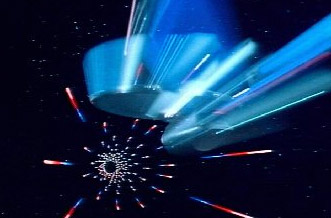On Friday, a news story came out that a second experiment seems to support the results of an earlier experiment which showed neutrinos might be moving faster than light. I commented about this on Google+ at the time, but I want to post about it here as well. Let me be clear: this new result does not confirm FTL neutrinos! What it did was essentially eliminate one possible source of error. A big one still remains.
 Let me recap: In September, a team of scientists
Let me recap: In September, a team of scientists at CERN working with the OPERA detector in Italy found that beams of neutrinos – subatomic particles that can travel straight through matter – seemed to get from the source in Geneva to the target in Italy 60 nanoseconds faster than a beam of light would make the trip. If true, it means they were moving faster than light (what scifi geeks like me call FTL) which, according to all the physics we understand, is impossible.
There was a lot of criticism of the experiment, as was expected and as it should be! It fell into two broad categories: a problem with the way they created the neutrinos, and a problem with timing.
The neutrinos were created at the accelerator at CERN as bursts containing gazillions of the particles. They move at essentially the speed of light, which is very fast. In fact, while the duration of the burst of neutrinos was very short in human terms, it was still long enough to blur out the results significantly. It’s like standing by the side of the road and trying to figure out when a cluster of cars passes you; do you measure the front of the cluster, the middle, or the tail end? In the case of the neutrinos, they didn’t know which neutrino was which; they measured all of them in the burst and used a statistical method to get an average travel time for each burst.
This is what a second experiment tried to answer. Using a different method the second time around, they were able to significantly tighten up the burst of neutrinos, reducing the error in the measurement by quite a bit. What they found were results consistent with the first experiment: the neutrinos traveled the 743 km trek 60 nanoseconds faster than light.
Holy cow! Does this prove the result?
No. Don’t forget the second source of error: timing. Most people, including me, think that the way they timed the experiment may be the source of the problem. This second experiment used the same timing techniques as the first! So if that’s the source of the error, this doesn’t really change anything.
And either way, we’re left where we were before: with a weird result that cannot really be confirmed or refuted without an independent experiment done by another group. That’s how science works.
I’ll note that another team of scientists has said the FTL results must be wrong due to energy arguments; that may be correct, but I still want to see a wholly separate experiment done. It’s much like nuking the aliens from orbit: it’s the only way to be sure.
Related posts:
- Faster-than-light travel discovered? Slow down, folks - Followup: FTL neutrinos explained? Not so fast, folks. - Wall Street Journal: neutrinos show climate change isn’t real - Followup on the WSJ climate denial OpEd